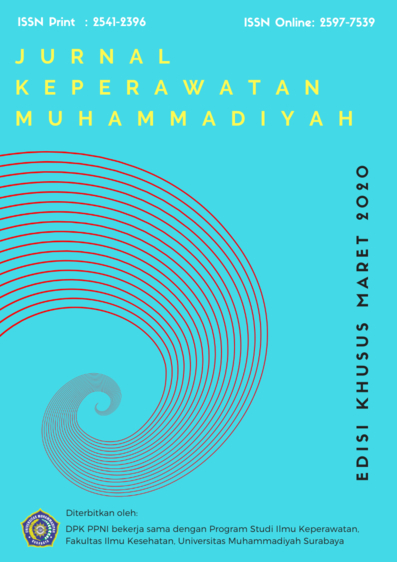Penerapan Model Pembelajaran Problem Based Learning : Literature Review
DOI:
https://doi.org/10.30651/jkm.v5i2.3949Keywords:
Midwifery Learning, Problem Based Learning Model, Effective LearningAbstract
The emphasis of midwifery education is the process of educating and enhancing the ability of individuals to become midwives who are able to carry out midwifery practices in a professional manner. To increase student graduation in the competency test, special attention is needed as well as a good learning process so that learning objectives can be achieved. One of the factors that causes the low quality of education is the factor of teaching and learning process (teaching learning). The purpose of conducting a competency test is to protect the community by providing assurance that registered entry level health workers have the required competencies. Problem-based learning model (Problem Based Learning) is a student-centered learning strategy, develops active learning, problem solving skills and field knowledge, and is based on understanding and solving problems. Study this literature through searching scientific publications in the 2017-2020 range using several databases namely Pubmed, Science Direct, and Wiley Online. as many as 7 articles that correspond to the objects discussed in the literature review with inclusion criteria and article search exclusion criteria. Pubmed literature search results N = 99, Science direct N = 67, Wiley N = 23, screening by title N = 14, Screening by Content N = 9. The use of appropriate learning methods can provide better learning outcomes, PBL is easier to apply and requires less preparation time, several techniques for applying problem based learning in the learning process: a) Paper Problem Based Learning, b) Virtual Problem-Based Learning , c) Scripting-based learning combining wearable technology, d) Hybrid Problem-Based LearningReferences
Amir, M. T. (2016). Inovasi Pendidikan Melalui Problem Based Learning (Cetakan Ke). Jakarta: Kencana Prenada Media Group.
Cong, L., Yan, Q., Sun, C., Zhu, Y., & Tu, G. (2017). Effect of problem and scripting-based learning on spine surgical trainees’ learning outcomes. European Spine Journal, 26(12), 3068–3074. https://doi.org/10.1007/s00586-017-5135-2
Farashahi, M., & Tajeddin, M. (2018). Effectiveness of teaching methods in business education: A comparison study on the learning outcomes of lectures, case studies and simulations. International Journal of Management Education, 16(1), 131–142. https://doi.org/10.1016/j.ijme.2018.01.003
Florentina Y. Sepe, M. N. I. B. (2018). PENGARUH MODEL PEMBELAJARAN PROBLEM BASED LEARNING (PBL) DAN COOPERATIVE SCRIPT (CS) TERHADAP KETERAMPILAN BERPIKIR KRITIS, MOTIVASI DAN HASIL BELAJAR MAHASISWA PADA MATA KULIAH ANATOMI FISIOLOGI MANUSIA DI UNIVERSITAS KATOLIK WIDYA MANDIRA KUPANG TAHUN A. Jurnal Biology Science & Education, 7(1), 97–106.
Fredrikson, M., Jha, S., & Ristenpart, T. (2015). Model Inversion Attacks that Exploit Confidence Information and Basic Countermeasures. In Proceedings of the 22nd ACM SIGSAC Conference on Comp and Commun Security - CCS ’15, ((pp. 1322–1333)).
Gerhardt-Szep, S., Kunkel, F., Moeltner, A., Hansen, M., Böckers, A., Rüttermann, S., & Ochsendorf, F. (2016). Evaluating differently tutored groups in problem-based learning in a German dental curriculum: A mixed methods study. BMC Medical Education, 16(1), 1–12. https://doi.org/10.1186/s12909-015-0505-0
Hameed, I., & Jan, T. U. (2016). 126 comparative study of teaching strategies in the higher education system of punjab and khyber pakhtunkhwa. Jurnal of Research [GUJR] Vol, 32(2), 126–134.
Hastuti, A., Sahidu, H., & Gunawan, G. (2017). Pengaruh Model PBL Berbantuan Media Virtual Tehadap Kemampuan Pemecahan Masalah Fisika. Jurnal Pendidikan Fisika Dan Teknologi, 2(3), 129. https://doi.org/10.29303/jpft.v2i3.303
Ikegami, A., Ohira, Y., Uehara, T., Noda, K., Suzuki, S., Shikino, K., … Ikusaka, M. (2017). Problem-based learning using patient-simulated videos showing daily life for a comprehensive clinical approach. International Journal of Medical Education, 8, 70–76. https://doi.org/10.5116/ijme.589f.6ef0
Kharay, S. S., Sharma, A., & Bansal, P. (2018). Evaluation of hybrid problem-based learning in large classrooms: a qualitative and quantitative analysis. International Journal of Research in Medical Sciences, 6(11), 3623–3628. Retrieved from https://msjonline.org/index.php/ijrms/article/view/5446/4281
Kononowicz, A. A., Zary, N., Edelbring, S., Corral, J., & Hege, I. (2015). Virtual patients - What are we talking about? A framework to classify the meanings of the term in healthcare education. BMC Medical Education, 15(1), 1–7. https://doi.org/10.1186/s12909-015-0296-3
Learning, I. H. P. (2019). Introducing Hybrid Problem-Based Learning Modules in Ayurveda Education: Results of an Exploratory Study. JOURNAL OF ALTERNATIVE AND COMPLEMENTARY MEDICINE, 00(00), 1–8. https://doi.org/10.1089/acm.2019.0293
Malik, A. S., & Malik, R. H. (2018). What really is Hybrid Problem-Based Learning Curriculum ? A review. Quest International Journal of Medical and Health Sciences.
Mushawwir, A., Tahir, T., Kadar, K., Khalid, N., & Ahmar, H. (2019). Jurnal Keperawatan Muhammadiyah. Jurnal Keperawatan Muhammadiyah Alamat, 60–68. Retrieved from http://journal.um-surabaya.ac.id/index.php/JKM/article/view/2343/2004
Mustari, R. (2019). FAKTOR-FAKTOR YANG MEMPENGARUHI PENGETAHUAN SIKAP DAN MOTIVASI TERHADAP UJI KOMPETENSI MAHASISWA D-III KEBIDANAN UIT MAKASSAR TAHUN 2017. JURNAL ILMIAH FORILKESUIT, 1(Icm).
Nila Yuliani, T. H., & Primanda, Y. (2017). PENGARUH SIKLUS BELAJAR 5E KOMBINASI PROBLEM BASED LEARNING (PBL) TERHADAP PENINGKATAN KOGNITIF, AFEKTIF, PSIKOMOTOR PADA MAHASISWA DIPLOMA KEPERAWATAN. NURSING PRACTICES, 1(3), 91–100.
Noor Cholifah, Rusnoto, D. hartinah. (2015). Bedside Sebagai Suatu Inovasi Metode Bimbingan Klinik Dalam kebidanan dan keperawatan. JIKK, 6(2).
Oderinu, O., Adegbulugbe, I., Orenuga, O., & Butali, A. (2019). Comparison of students’ perception of problemâ€based learning and traditional teaching method in a Nigerian dental school. European Journal of Dental Education. https://doi.org/10.1111/eje.12486
Savin-Baden, M., & Wilkie, K. (2006). Problem-based Learning Online,. UK: Open University Press.
Schmidt, H. G., Rotgans, J. I., & Yew, E. H. J. (2011). The process of problem-based learning: What works and why. Medical Education, 45(8), 792–806. https://doi.org/10.1111/j.1365-2923.2011.04035.x
Servant-Miklos, V. F. C. (2019). Fifty Years on: A Retrospective on the World’s First Problem-based Learning Programme at McMaster University Medical School. Health Professions Education, 5(1), 3–12. https://doi.org/10.1016/j.hpe.2018.04.002
Sobocan, M., Turk, N., Dinevski, D., Hojs, R., & Balon, B. P. (2017). Problem-Based Learning in Internal Medicine: Virtual Patients or Paper-Based Problems. Internal Medicine Journal, 4–6. https://doi.org/10.1111/1744-1633.12020
Zhao, X., & Cong, L. (2019). Effect of problem and scripting-based learning combining wearable technology on orthopedic operating room nurses’ learning outcomes. Nurse Education Today, 73(155), 13–16. https://doi.org/10.1016/j.nedt.2018.11.005
Downloads
Published
Issue
Section
License
- Penulis tetap memegang hak atas karyanya dan memberikan hak publikasi pertama kepada jurnal ini yang secara simultan karya tersebut dilisensikan di bawah:Â Creative Commons Attribution-ShareAlike 4.0 International (CC BY-SA 4.0)













